2014 MERCEDES-BENZ GL height
[x] Cancel search: heightPage 19 of 462
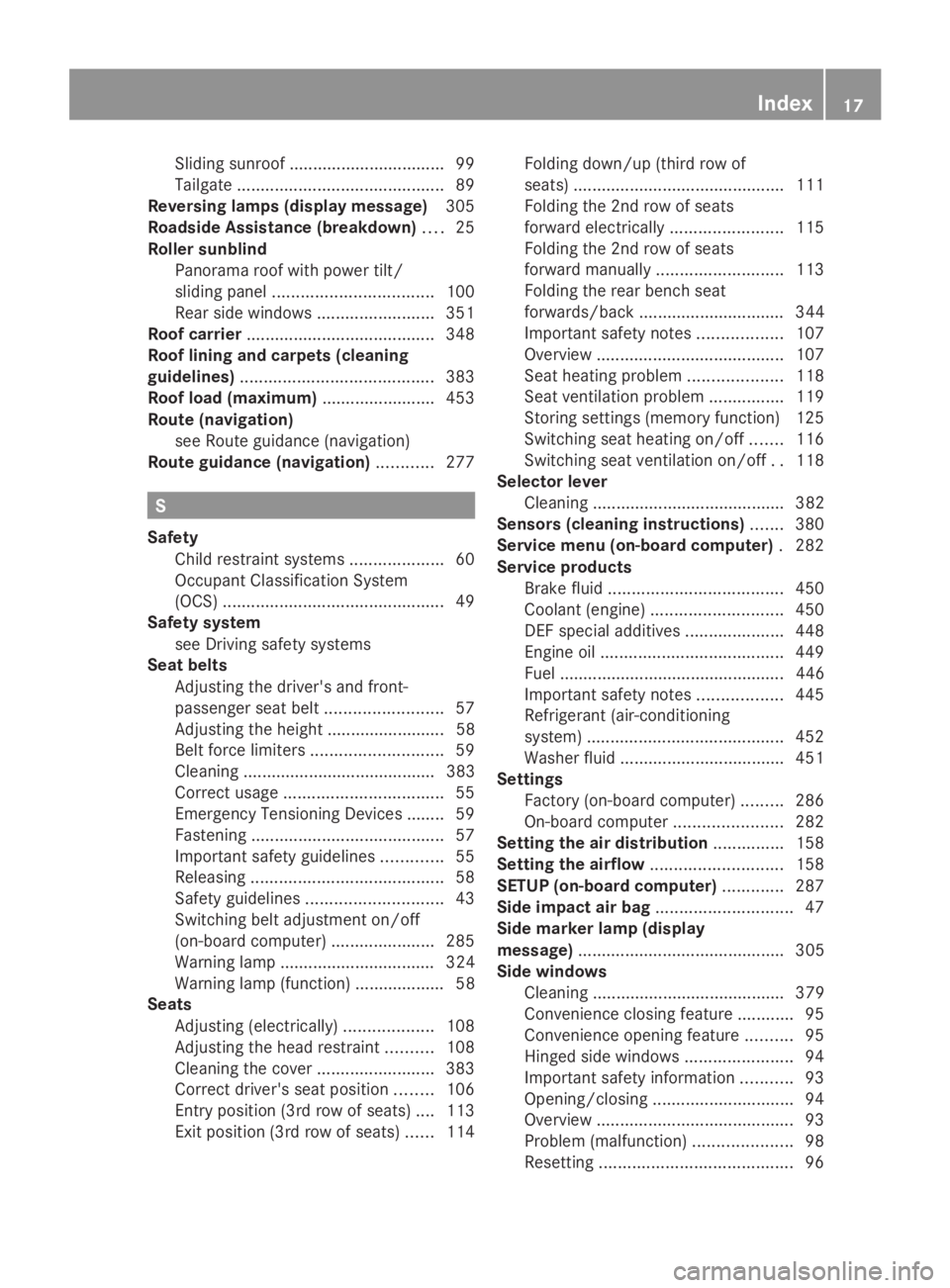
Sliding sunroof.................................99
Tailgate............................................89
Reversing lamps (display message)305
Roadside Assistance (breakdown)....25
Roller sunblind
Panorama roof with power tilt/
sliding panel..................................100
Rear side windows.........................351
Roof carrier........................................348
Roof lining and carpets (cleaning
guidelines).........................................383
Roof load (maximum)........................453
Route (navigation)
see Route guidance (navigation)
Route guidance (navigation)............277
S
Safety
Child restraint systems....................60
Occupant Classification System
(OCS)...............................................49
Safety system
see Driving safety systems
Seat belts
Adjusting the driver's and front-
passenger seat belt.........................57
Adjusting the height ......................... 58
Belt force limiters............................59
Cleaning ......................................... 383
Correct usage..................................55
Emergency Tensioning Devices ........59
Fastening.........................................57
Important safety guidelines.............55
Releasing.........................................58
Safety guidelines.............................43
Switching belt adjustment on/off
(on-board computer)......................285
Warning lamp ................................. 324
Warning lamp (function) ................... 58
Seats
Adjusting (electrically)...................108
Adjusting the head restraint..........108
Cleaning the cover.........................383
Correct driver's seat position........106
Entry position (3rd row of seats)....113
Exit position (3rd row of seats)......114
Folding down/up (third row of
seats) .............................................111
Folding the 2nd row of seats
forward electrically........................115
Folding the 2nd row of seats
forward manually...........................113
Folding the rear bench seat
forwards/back ............................... 344
Important safety notes..................107
Overview........................................107
Seat heating problem....................118
Seat ventilation problem................119
Storing settings (memory function) 125
Switching seat heating on/off.......116
Switching seat ventilation on/off..118
Selector lever
Cleaning ......................................... 382
Sensors (cleaning instructions).......380
Service menu (on-board computer).282
Service products
Brake fluid.....................................450
Coolant (engine)............................450
DEF special additives.....................448
Engine oil.......................................449
Fuel ................................................ 446
Important safety notes..................445
Refrigerant (air-conditioning
system)..........................................452
Washer fluid ...................................451
Settings
Factory (on-board computer).........286
On-board computer.......................282
Setting the air distribution...............158
Setting the airflow............................158
SETUP (on-board computer).............287
Side impact air bag.............................47
Side marker lamp (display
message)............................................ 305
Side windows
Cleaning ......................................... 379
Convenience closing feature............95
Convenience opening feature..........95
Hinged side windows.......................94
Important safety information...........93
Opening/closing..............................94
Overview..........................................93
Problem (malfunction).....................98
Resetting.........................................96
Index17
Page 58 of 462
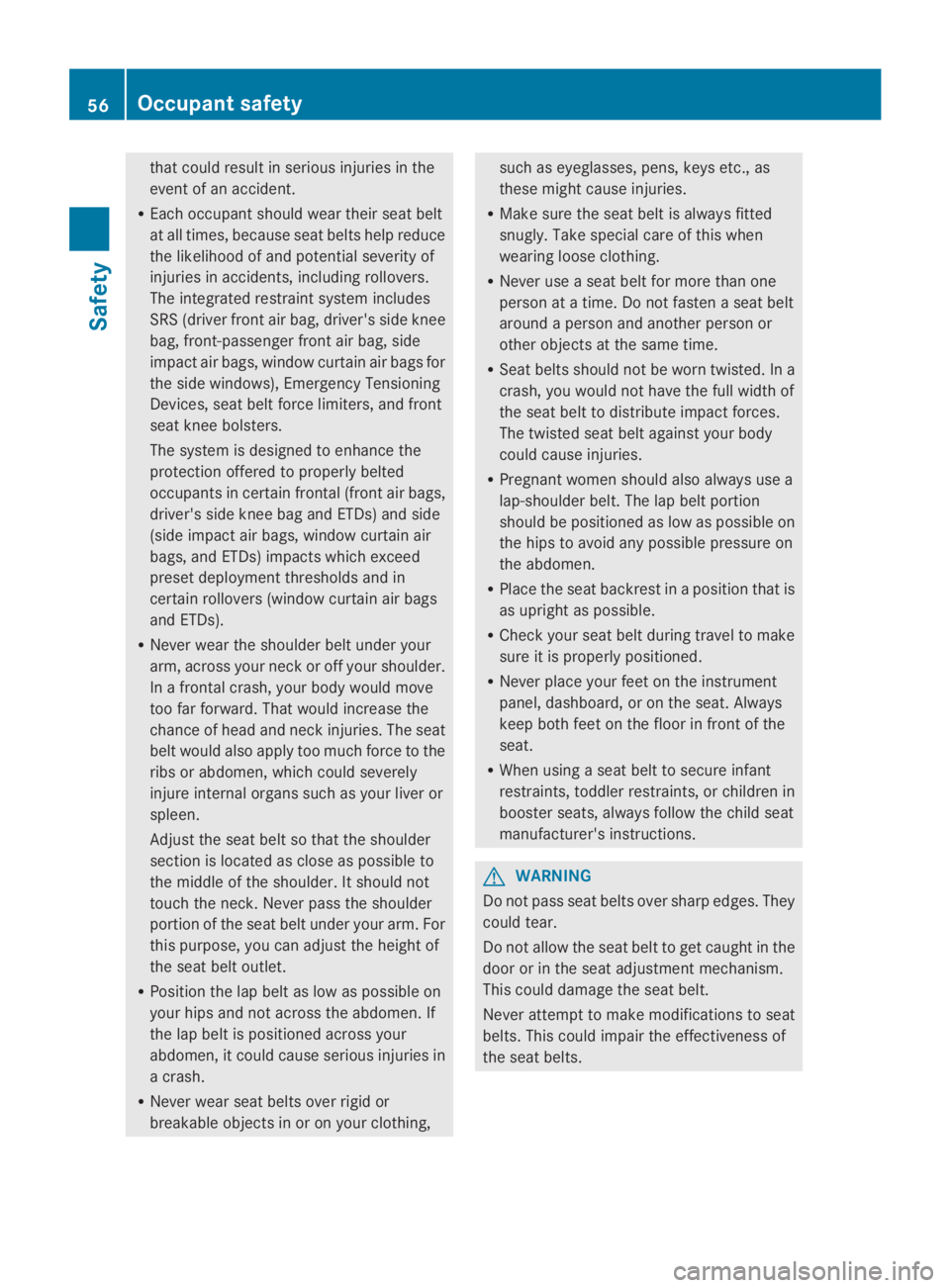
that could result in serious injuries in the
event of an accident.
REach occupant should wear their seat belt
at all times, because seat belts help reduce
the likelihood of and potential severity of
injuries in accidents, including rollovers.
The integrated restraint system includes
SRS (driver front air bag, driver's side knee
bag, front-passenger front air bag, side
impact air bags, window curtain air bags for
the side windows), Emergency Tensioning
Devices, seat belt force limiters, and front
seat knee bolsters.
The system is designed to enhance the
protection offered to properly belted
occupants in certain frontal (front air bags,
driver's side knee bag and ETDs) and side
(side impact air bags, window curtain air
bags, and ETDs) impacts which exceed
preset deployment thresholds and in
certain rollovers (window curtain air bags
and ETDs).
RNever wear the shoulder belt under your
arm, across your neck or off your shoulder.
In a frontal crash, your body would move
too far forward. That would increase the
chance of head and neck injuries. The seat
belt would also apply too much force to the
ribs or abdomen, which could severely
injure internal organs such as your liver or
spleen.
Adjust the seat belt so that the shoulder
section is located as close as possible to
the middle of the shoulder. It should not
touch the neck. Never pass the shoulder
portion of the seat belt under your arm. For
this purpose, you can adjust the height of
the seat belt outlet.
RPosition the lap belt as low as possible on
your hips and not across the abdomen. If
the lap belt is positioned across your
abdomen, it could cause serious injuries in
a crash.
RNever wear seat belts over rigid or
breakable objects in or on your clothing,
such as eyeglasses, pens, keys etc., as
these might cause injuries.
RMake sure the seat belt is always fitted
snugly. Take special care of this when
wearing loose clothing.
RNever use a seat belt for more than one
person at a time. Do not fasten a seat belt
around a person and another person or
other objects at the same time.
RSeat belts should not be worn twisted. In a
crash, you would not have the full width of
the seat belt to distribute impact forces.
The twisted seat belt against your body
could cause injuries.
RPregnant women should also always use a
lap-shoulder belt. The lap belt portion
should be positioned as low as possible on
the hips to avoid any possible pressure on
the abdomen.
RPlace the seat backrest in a position that is
as upright as possible.
RCheck your seat belt during travel to make
sure it is properly positioned.
RNever place your feet on the instrument
panel, dashboard, or on the seat. Always
keep both feet on the floor in front of the
seat.
RWhen using a seat belt to secure infant
restraints, toddler restraints, or children in
booster seats, always follow the child seat
manufacturer's instructions.
GWARNING
Do not pass seat belts over sharp edges. They
could tear.
Do not allow the seat belt to get caught in the
door or in the seat adjustment mechanism.
This could damage the seat belt.
Never attempt to make modifications to seat
belts. This could impair the effectiveness of
the seat belts.
56Occupant safety
Safety
Page 60 of 462
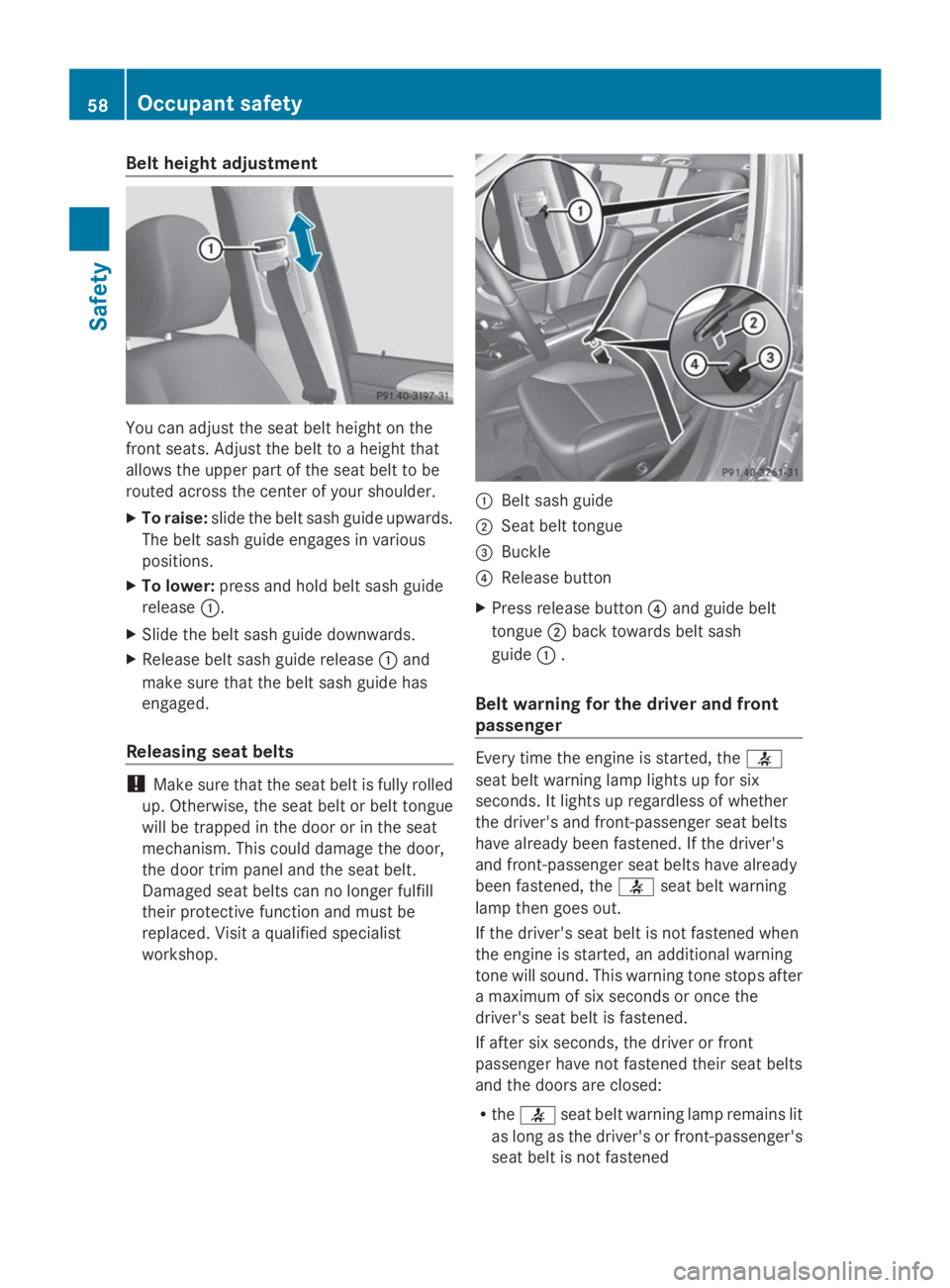
Belt height adjustment
You can adjust the seat belt height on the
front seats. Adjust the belt to a height that
allows the upper part of the seat belt to be
routed across the center of your shoulder.
XTo raise:slide the belt sash guide upwards.
The belt sash guide engages in various
positions.
XTo lower:press and hold belt sash guide
release�C.
XSlide the belt sash guide downwards.
XRelease belt sash guide release�Cand
make sure that the belt sash guide has
engaged.
Releasing seat belts
!Make sure that the seat belt is fully rolled
up. Otherwise, the seat belt or belt tongue
will be trapped in the door or in the seat
mechanism. This could damage the door,
the door trim panel and the seat belt.
Damaged seat belts can no longer fulfill
their protective function and must be
replaced. Visit a qualified specialist
workshop.
�CBelt sash guide
�DSeat belt tongue
�
Page 64 of 462

positioning for children over 41 lb (18 kg) until
they reach a height where a lap-shoulder belt
fits properly without a booster.
When the child restraint is not in use, remove
it from the vehicle or secure it with the seat
belt to prevent the child restraint from
becoming a projectile in the event of an
accident.
GWARNING
If children are left unsupervised in the vehicle,
they could:
Ropen the doors, thus endangering other
people or road users.
Rget out and disrupt traffic.
Roperate the vehicle's equipment.
Additionally, children could set the vehicle in
motion if, for example, they:
Rrelease the parking brake.
Rshifting the automatic transmission out of
park positionP
RStart the engine.
There is a risk of an accident and injury.
When leaving the vehicle, always take the
SmartKey with you and lock the vehicle. Never
leave children or animals unattended in the
vehicle. Always keep the SmartKey out of
reach of children.
GWARNING
If persons, particularly children are subjected
to prolonged exposure to extreme heat or
cold, there is a risk of injury, possibly even
fatal. Never leave children unattended in the
vehicle.
GWARNING
If the child restraint system is subjected to
direct sunlight, parts may get very hot.
Children may burn themselves on these parts,
particularly on the metal parts of the child
restraint system. There is a risk of injury.
If you leave the vehicle, taking the child with
you, always ensure that the child restraint
system is not exposed to direct sunlight.
Protect it with a blanket, for example. If the
child restraint system has been exposed to
direct sunlight, let it cool down before
securing the child in it. Never leave children
unattended in the vehicle.
If an infant or child is traveling in the vehicle:
RSecure the child with a child or infant seat
restraint system appropriate to the age and
weight of the child.
RMake sure that the infant or child is
properly secured at all times while the
vehicle is in motion.
Mercedes-Benz recommends that you always
properly secure all infants and children with
a child or infant seat restraint system for the
trip.
The use of seat belts and infant and child
restraint systems is required by law in:
Rall 50 states
Rthe U.S. territories
Rthe District of Columbia
Rall Canadian provinces
Infants and children must always be seated in
an appropriate infant or child restraint system
recommended for the size and weight of the
child. The infant or child restraint system
must be properly secured in accordance with
the manufacturer's instructions.
All infant or child restraint systems must meet
the following standards:
RU.S. Federal Motor Vehicle Safety
Standards 213 and 225
RCanadian Motor Vehicle Safety Standards
213 and 210.2
Confirmation that the child restraint system
corresponds to the standards can be found
on an instruction label on the child restraint
system. This confirmation can also be found
in the installation instructions that are
included with the child restraint system.
Always read and follow the manufacturer's
instructions when using an infant or child
restraint system or booster seat.
62Children in the vehicle
Safety
Page 109 of 462
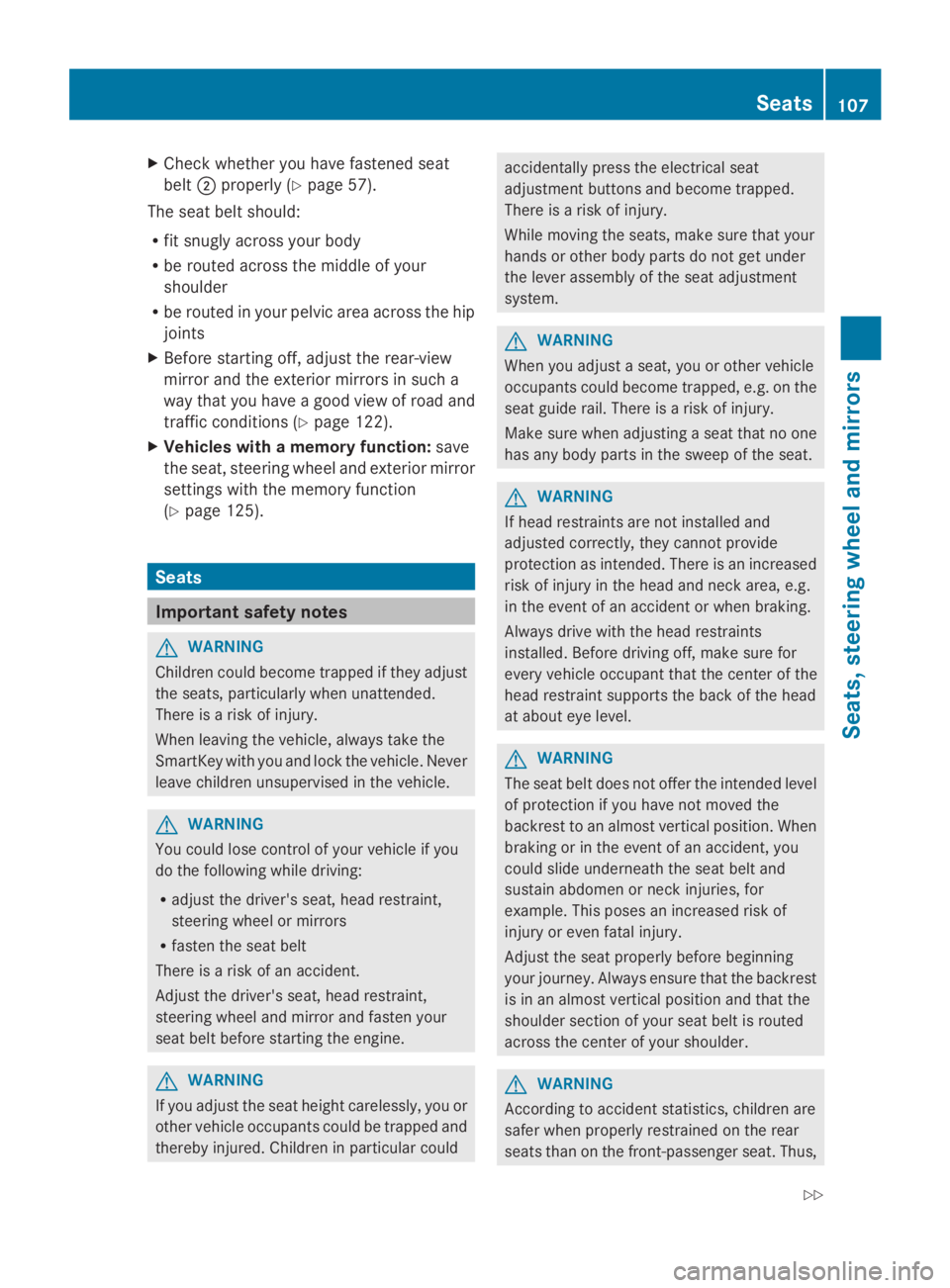
XCheck whether you have fastened seat
belt�Dproperly (Ypage 57).
The seat belt should:
Rfit snugly across your body
Rbe routed across the middle of your
shoulder
Rbe routed in your pelvic area across the hip
joints
XBefore starting off, adjust the rear-view
mirror and the exterior mirrors in such a
way that you have a good view of road and
traffic conditions (Ypage 122).
XVehicles with a memory function:save
the seat, steering wheel and exterior mirror
settings with the memory function
(Ypage 125).
Seats
Important safety notes
GWARNING
Children could become trapped if they adjust
the seats, particularly when unattended.
There is a risk of injury.
When leaving the vehicle, always take the
SmartKey with you and lock the vehicle. Never
leave children unsupervised in the vehicle.
GWARNING
You could lose control of your vehicle if you
do the following while driving:
Radjust the driver's seat, head restraint,
steering wheel or mirrors
Rfasten the seat belt
There is a risk of an accident.
Adjust the driver's seat, head restraint,
steering wheel and mirror and fasten your
seat belt before starting the engine.
GWARNING
If you adjust the seat height carelessly, you or
other vehicle occupants could be trapped and
thereby injured. Children in particular could
accidentally press the electrical seat
adjustment buttons and become trapped.
There is a risk of injury.
While moving the seats, make sure that your
hands or other body parts do not get under
the lever assembly of the seat adjustment
system.
GWARNING
When you adjust a seat, you or other vehicle
occupants could become trapped, e.g. on the
seat guide rail. There is a risk of injury.
Make sure when adjusting a seat that no one
has any body parts in the sweep of the seat.
GWARNING
If head restraints are not installed and
adjusted correctly, they cannot provide
protection as intended. There is an increased
risk of injury in the head and neck area, e.g.
in the event of an accident or when braking.
Always drive with the head restraints
installed. Before driving off, make sure for
every vehicle occupant that the center of the
head restraint supports the back of the head
at about eye level.
GWARNING
The seat belt does not offer the intended level
of protection if you have not moved the
backrest to an almost vertical position. When
braking or in the event of an accident, you
could slide underneath the seat belt and
sustain abdomen or neck injuries, for
example. This poses an increased risk of
injury or even fatal injury.
Adjust the seat properly before beginning
your journey. Always ensure that the backrest
is in an almost vertical position and that the
shoulder section of your seat belt is routed
across the center of your shoulder.
GWARNING
According to accident statistics, children are
safer when properly restrained on the rear
seats than on the front-passenger seat. Thus,
Seats107
Seats, steering wheel and mirrors
Z
Page 110 of 462
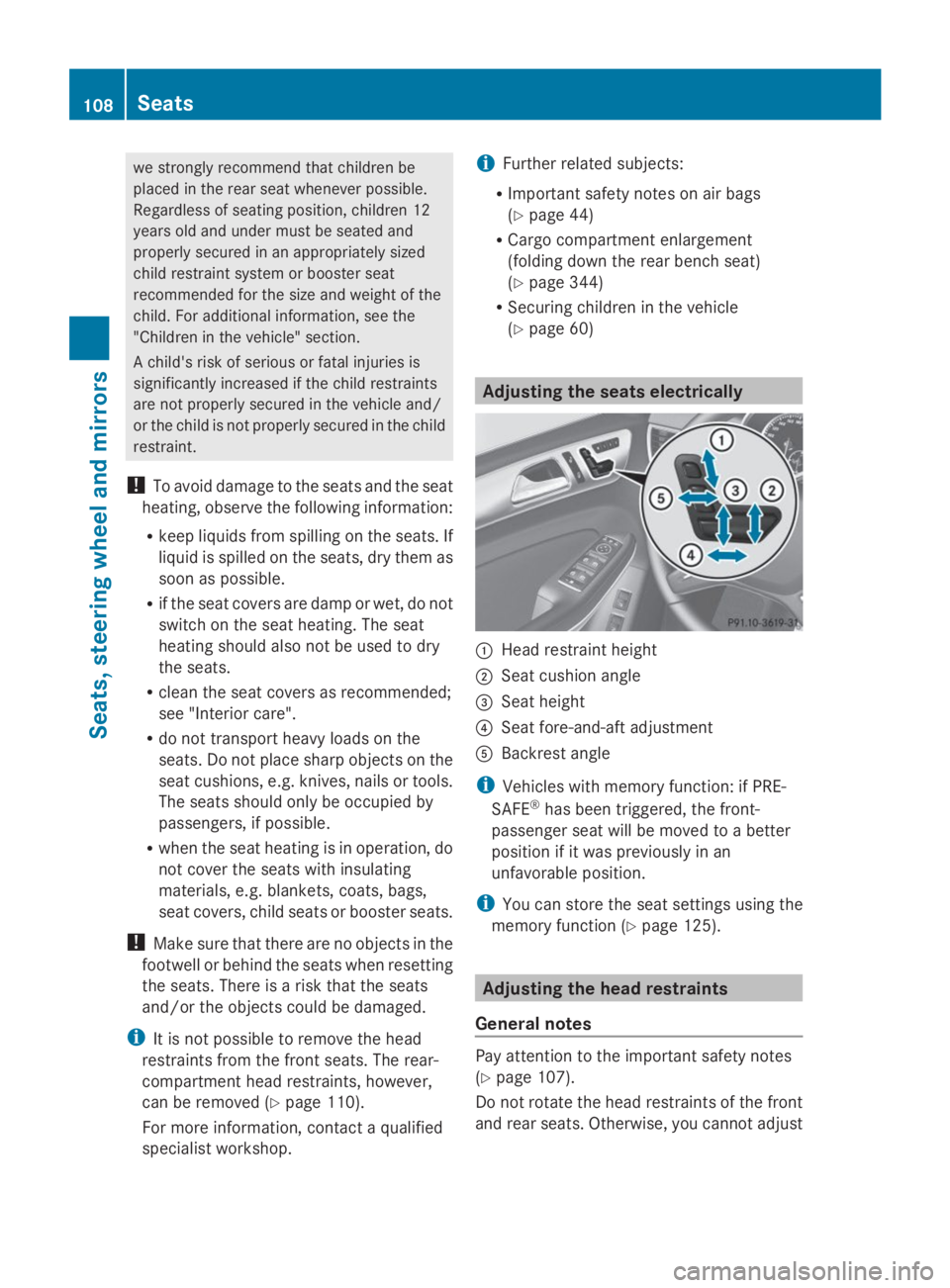
we strongly recommend that children be
placed in the rear seat whenever possible.
Regardless of seating position, children 12
years old and under must be seated and
properly secured in an appropriately sized
child restraint system or booster seat
recommended for the size and weight of the
child. For additional information, see the
"Children in the vehicle" section.
A child's risk of serious or fatal injuries is
significantly increased if the child restraints
are not properly secured in the vehicle and/
or the child is not properly secured in the child
restraint.
!To avoid damage to the seats and the seat
heating, observe the following information:
Rkeep liquids from spilling on the seats. If
liquid is spilled on the seats, dry them as
soon as possible.
Rif the seat covers are damp or wet, do not
switch on the seat heating. The seat
heating should also not be used to dry
the seats.
Rclean the seat covers as recommended;
see "Interior care".
Rdo not transport heavy loads on the
seats. Do not place sharp objects on the
seat cushions, e.g. knives, nails or tools.
The seats should only be occupied by
passengers, if possible.
Rwhen the seat heating is in operation, do
not cover the seats with insulating
materials, e.g. blankets, coats, bags,
seat covers, child seats or booster seats.
!Make sure that there are no objects in the
footwell or behind the seats when resetting
the seats. There is a risk that the seats
and/or the objects could be damaged.
iIt is not possible to remove the head
restraints from the front seats. The rear-
compartment head restraints, however,
can be removed (Ypage 110).
For more information, contact a qualified
specialist workshop.
iFurther related subjects:
RImportant safety notes on air bags
(Ypage 44)
RCargo compartment enlargement
(folding down the rear bench seat)
(Ypage 344)
RSecuring children in the vehicle
(Ypage 60)
Adjusting the seats electrically
�CHead restraint height
�DSeat cushion angle
�
Page 111 of 462

the height and angle of the head restraints to
the correct position.
Adjusting the head restraints manually
Adjusting the head restraint height
XTo raise:pull the head restraint up to the
desired position.
XTo lower:press release catch�Cin the
direction of the arrow and push the head
restraint down to the desired position.
Adjusting the fore/aft position of the
head restraint
With this function you can adjust the distance
between the head restraint and the back of
the seat occupant's head.
XTo adjust forwards:pull the head restraint
forwards in the direction of the arrow until
it engages.
There are several notches.
XTo move backwards:press and hold
release button�Cand push the head
restraint backwards.
XWhen the head restraint is in the desired
position, release the button and make sure
that the head restraint is engaged in
position.
iAdjust the head restraint so that the back
of your head is as close to the head
restraint as possible.
Adjusting the head restraints
electrically
XTo adjust the head restraint height:slide
the switch for head restraint adjustment
(Ypage 108) up or down in the direction of
the arrow.
Adjusting the luxury head restraints
XTo adjust the side bolsters of the head
restraint:push or pull right and/or left-
hand side bolster�Cinto the desired
position.
XTo adjust the fore/aft position of the
head restraint:push or pull the head
restraint in the direction of arrow�D.
iAdjust the head restraint so that the back
of your head is as close to the head
restraint as possible.
Seats109
Seats, steering wheel an d mirrors
Z
Page 112 of 462
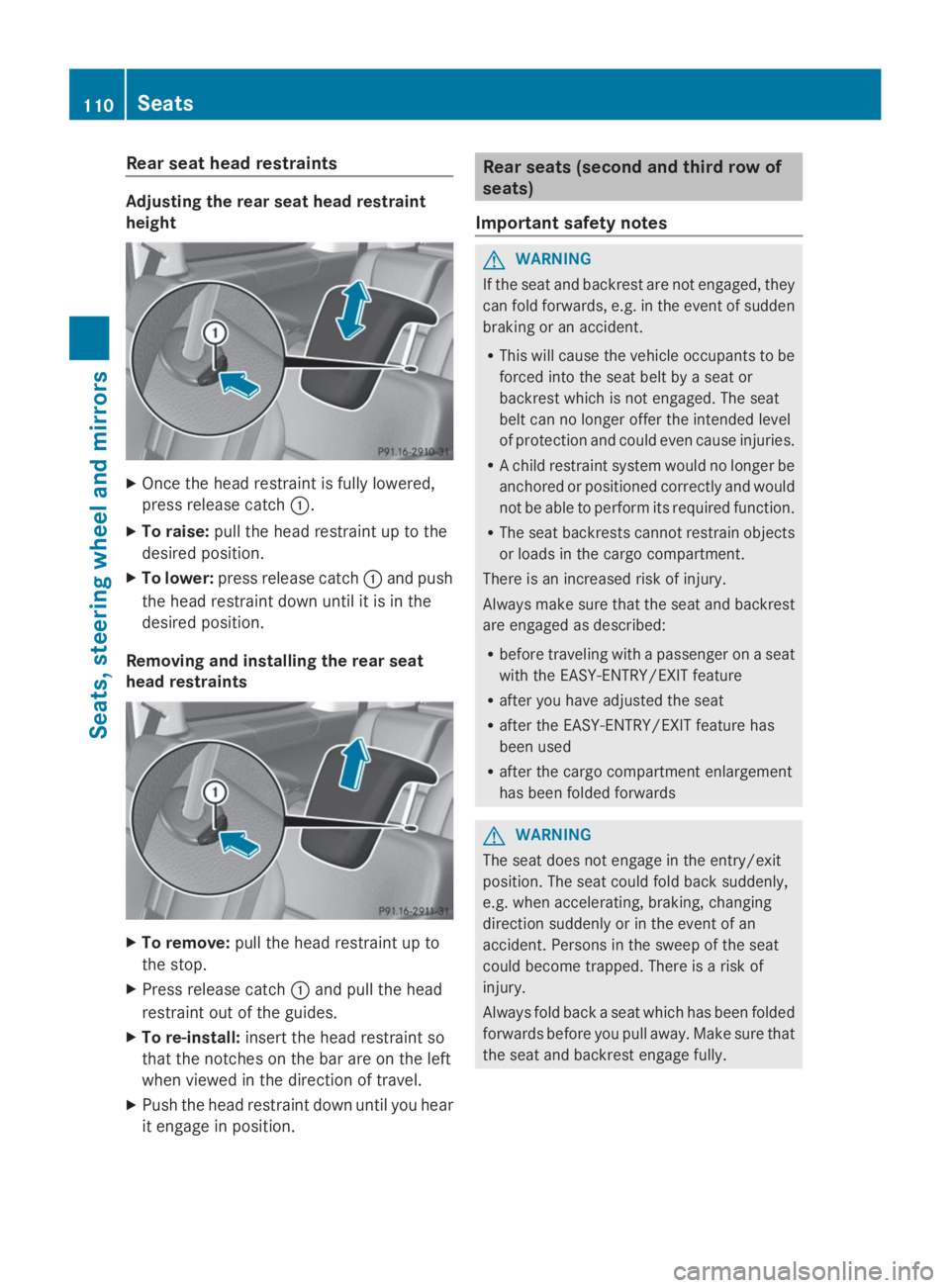
Rear seat head restraints
Adjusting the rear seat head restraint
height
XOnce the head restraint is fully lowered,
press release catch�C.
XTo raise:pull the head restraint up to the
desired position.
XTo lower:press release catch�Cand push
the head restraint down until it is in the
desired position.
Removing and installing the rear seat
head restraints
XTo remove:pull the head restraint up to
the stop.
XPress release catch�Cand pull the head
restraint out of the guides.
XTo re-install:insert the head restraint so
that the notches on the bar are on the left
when viewed in the direction of travel.
XPush the head restraint down until you hear
it engage in position.
Rear seats (second and third row of
seats)
Important safety notes
GWARNING
If the seat and backrest are not engaged, they
can fold forwards, e.g. in the event of sudden
braking or an accident.
RThis will cause the vehicle occupants to be
forced into the seat belt by a seat or
backrest which is not engaged. The seat
belt can no longer offer the intended level
of protection and could even cause injuries.
RA child restraint system would no longer be
anchored or positioned correctly and would
not be able to perform its required function.
RThe seat backrests cannot restrain objects
or loads in the cargo compartment.
There is an increased risk of injury.
Always make sure that the seat and backrest
are engaged as described:
Rbefore traveling with a passenger on a seat
with the EASY-ENTRY/EXIT feature
Rafter you have adjusted the seat
Rafter the EASY-ENTRY/EXIT feature has
been used
Rafter the cargo compartment enlargement
has been folded forwards
GWARNING
The seat does not engage in the entry/exit
position. The seat could fold back suddenly,
e.g. when accelerating, braking, changing
direction suddenly or in the event of an
accident. Persons in the sweep of the seat
could become trapped. There is a risk of
injury.
Always fold back a seat which has been folded
forwards before you pull away. Make sure that
the seat and backrest engage fully.
110Seats
Seats, steering wheel and mirrors